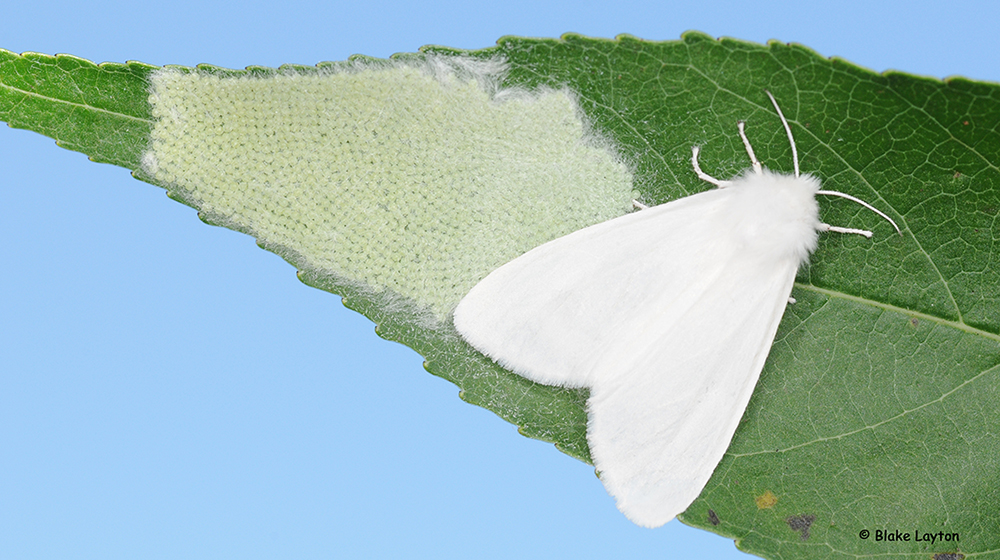Fall Webworm, Vol. 2, No. 30
Related News
October 1, 2013
September 10, 2013
June 24, 2013
June 20, 2013

This is how those large webs that are so common in pecan, persimmon, and sweetgum trees this time of year get started. The female moths lay their pale green eggs in a single-layered mass on the underside of a leaf. After hatching, the caterpillars work together to build a small protective web around the leaves they are feeding on. As the caterpillars grow, they expand the web to include new leaves. This gives them a ready food supply in an environment where they are protected from predators. The female moth in this photo is about ¾ inches long and happens to be pure white, but many specimens are white with black spots. The spots vary in size and number, and some specimens are heavily spotted. Fall webworms are a rather rare case of a native U.S. insect that has become an invasive pest in other parts of the world, such as China, North Korea, and Japan.
They are called fall webworms because they are most numerous in the fall, but here in the Deep South, there are two or three generations per year, and webs can be seen in early June. Although they can occur on most hardwood trees, pecan seems to be their most favored host here in Mississippi, and webworms often cause serious damage to pecan trees in home lawns. During heavy outbreak years, trees can be completely defoliated, with the entire canopy encased in webs.
Control is not a problem in commercial pecan orchards where large air-blast sprayers capable of spraying 50+ feet into the canopy are used to apply insecticides and fungicides. In fact, it is uncommon for commercial pecan producers to spray specifically for webworms because they are often controlled coincidentally by sprays applied for other insect pests. The situation is much different in home lawns where such equipment is not available and where insecticide drift onto neighboring lawns is a significant concern. In many cases, it is not practical to treat webworms on trees in home lawns.
Small trees, up to about 20 feet tall, can be treated with a hose-end tree and shrub sprayer, or some other type of sprayer that will reach high enough. Insecticides containing the active ingredient spinosad (Bonide, Greenlight, Ferti-lome, and Monterey products) are a good choice for treating webworms, as well as other caterpillar pests. Using a fishing pole with a clothes hanger hook taped to the end to tear up the webs is a non-insecticidal method of removing the webs and exposing the caterpillars to predators.
See page 19 of Extension Publication 2369, Insect Pests of Ornamental Plants in the Home Landscape, for more information on fall webworms.
Blake Layton, Extension Entomology Specialist, Mississippi State University Extension Service. The information given here is for educational purposes only. Always read and follow current label directions. Specific commercial products are mentioned as examples only and reference to specific products or trade names is made with the understanding that no discrimination is intended to other products that may also be suitable and appropriately labeled.
Sign up to receive Bug's Eye View.